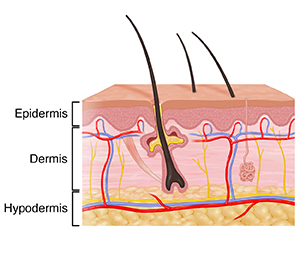Common Types of Skin Cancer
Skin cancer is a serious disease that can affect anyone at any age. It's the most common kind of cancer in the U.S. If found early, when it's small and hasn't spread, some of the more common types of skin cancer can often be cured. But some types of skin cancer can be life-threatening.
Talk with your healthcare provider about what you can do to help prevent skin cancer. Ask about regular skin exams as part of your routine physicals. You can also ask about doing monthly self-exams of your skin. If you see any changes in your skin, see your healthcare provider right away.
Understanding the skin
The skin is made up of three layers: epidermis, dermis, and hypodermis:
-
Epidermis. This is the thin outer layer of the skin. The epidermis is made of multiple layers. It's the main barrier to the world outside our bodies. It's made primarily of two types of cells: keratinocytes and melanocytes.
-
-
Keratinocytes are the most common type of cells in the epidermis. They are the structural cells of the epidermis. They are sometimes divided into several groups:
-
Basal cells are round cells found at the inner base layer of the epidermis. These divide to replace lost skin cells. As new skin cells are formed, they flatten and move closer to the surface of the skin.
-
Squamous cells are flat cells in the outermost layer of the epidermis. They are always shedding off as new ones are forming.
-
Melanocytesare scattered through the basal layer. They make melanin to give skin its color.
-
Dermis.This middle layer of skin is where blood and lymph vessels, hair follicles, oil and sweat glands, nerves, and collagen are found. It supports the epidermis and is a key part of wound healing. It also gives the skin flexibility and strength.
-
Hypodermis.This is the deepest layer of the skin. It's made of fat, collagen, and blood vessels. It helps insulate the body and absorb shock, and it protects the body from injury.

Most skin cancer forms in the epidermis. It usually starts in the keratinocytes or melanocytes.
Skin cancer can be grouped into two types: non-melanoma (also called keratinocyte carcinomas) and melanoma.
The two most common types of non-melanoma skin cancer are basal cell carcinoma and squamous cell carcinoma.
Basal cell cancer
Basal cell cancer is the most common type of skin cancer. It is derived from young keratinocytes, and under the microscope looks most like the round basal cells seen at the base of the epidermis. It's usually found on sun-exposed skin, like the face, ears, neck, trunk, or arms, but it can start anywhere.
These lesions vary in color and may be waxy, pearly, scaly, or scar-like. Tiny blood vessels can sometimes be seen through the lesion’s surface. These lesions can bleed easily and might not heal well. Nearly all basal cell cancers can be treated and cured if they're found early.
Squamous cell cancer
Squamous cell cancer is the second most common type of skin cancer. It is also derived from young keratinocytes, but under the microscope looks more like flat squamous cells. Lesions often form on the face, ears, neck, hands, or arms—places that get a lot of sun. The lesions are firm, red bumps or flat, scaly, crusty growths. They may be sores that keep healing and reopening.
Squamous cell carcinoma is more likely to grow and spread to other parts of the body than basal cell carcinoma, though this is rare. Most squamous cell carcinoma is found early enough to be treated and cured.
Melanoma
Melanoma is a less common but much more dangerous kind of skin cancer. It starts in skin cells called melanocytes. It's much more likely to grow and spread than basal or squamous cell cancers. Finding and treating it early is key.
It's often not easy to tell where a melanoma lesion’s borders are. It's often brown or black but may be a mix of colors with pink, tan, or white. The shape and size of melanoma lesions tend to differ from one side to the other. Melanoma is most often found on sun-exposed skin, but it can start anywhere, like the genitals, mouth, palms of hands, bottoms of feet, under the nails, and even in your eyes.
Less common skin cancers
There are other serious types of non-melanoma skin cancer, too. These include Merkel cell cancer, Kaposi sarcoma, and skin (cutaneous) lymphomas, but these cancers are very rare.
Actinic keratosis
Actinic keratosis (AK) is not skin cancer. AK develops when there is damage to keratinocytes, most often caused by too much sun exposure. It's a common, pre-cancer skin change that can turn into a squamous cell skin cancer over time if it's not treated. Most AK doesn't turn into cancer, but it's important to have any skin changes looked at by a healthcare provider.
AK lesions tend to be found on sun-exposed parts of the body. They can be pink, reddish-brown, or skin-colored. These lesions are often small, raised, scaly, and rough, like sandpaper. In some cases, AK lesions hurt. Most people with them have more than one lesion. Getting early treatment for AK almost always cures the lesions.